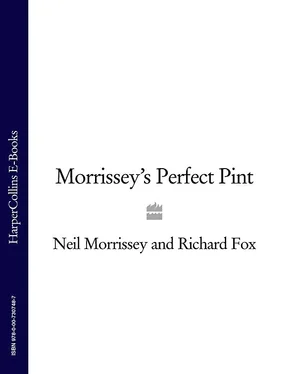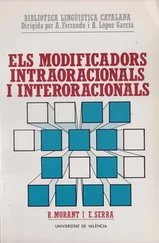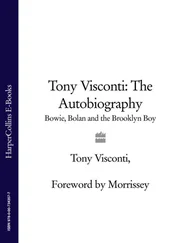F:…it was safer than water! Recycled grain was used to make ‘small beer’, which was the piss-weak everyday stuff given to women and children and served at breakfast. The better stuff was given to farm-workers, prescribed by doctors, used in religious ceremonies and other celebrations. You didn’t need to have a drink problem to have a drink problem in those days.
M:Which isn’t to deny that getting muntered was high on everybody’s agenda. Because there was no way to measure or control the alcoholic content, apart from re-brewing the grains to make ‘small beer’, ale was often wickedly strong. The eighth-century missionary, St Boniface, wrote that in Britain ‘the vice of drunkenness is too frequent. This is an evil peculiar to pagans and to our race. Neither the Franks nor the Gauls nor the Lombards nor the Romans nor the Greeks commit it.’
F:Interestingly, drinking from glasses didn’t occur until much later. People drank out of pigskin pitchers, horns and bowls which couldn’t be put down like a glass, so ‘down in one’ was common. Communal bowls were marked by pegs and pins, indicating where one customer’s portion of ale started and finished. Drinking more than your fair share became known as ‘taking someone down a peg or two’. One novelty of the late 17th century was the whistling tankard, which had a whistle at the bottom so you could call the landlord when you needed a top up!
M:That’s one for the Innovations catalogue, methinks. Another change in the 17th century was a bit of a disaster. Because they were worried about losing revenue, the King and Parliament cut duties on gin to encourage people to drink it instead of French brandy. Imagine their surprise when this produced an epidemic of gin-necking which made today’s so-called binge drinking look like a tea dance in Rhyl.
F:And gin in those days was the original rocket fuel, often over double the strength of today’s sophisticated aperitif. This had the unintended but gratifying effect of making beer drinking respectable by comparison. William Hogarth, the 18th century artist, made two engravings called Beer Street and Gin Lane that showed the former as an ordered, happy, pleasant environment and the latter as a horror-filled chaos.
M:Like Harrogate on a Saturday night but actually much worse. The 18th century saw the big commercial brewers establish themselves and take most of the business from small, independent brewers who had been the backbone of British beer-making. Science helped with devices like the steam engine and hydrometer which allowed larger quantities to be brewed with greater precision. Also, better roads meant cheaper, mass-produced beer could be transported to places that had previously relied on alewives and alcoholic monks for their bevvy.
F:Ah yes, science. In the 19th century Louis Pasteur dealt the small beer producers a double whammy when he grew yeast in the laboratory, meaning that brewers no longer had to rely on wild, airborne yeasts for fermentation. He also invented ‘pasteurisation’, which meant beer could be easily treated to stay fresh longer. Beer-remained a mainstay of the working man’s diet until well into the 20th century when food became more plentiful. Industrialisation also saw a drop in the demand for physical labour, which meant more machines powered by oil and less men fuelled by beer. The world changed, Neil.
M:Indeed it did, Foxy. The invasion of bland German lagers, in the 60s, when TV advertising emerged and teenagers flexed their drinking muscles at the pub, saw a big decline in beer drinking, but there are signs of a comeback, with the growth of artisan breweries and specialist beers. It may not be the lifeblood of the nation, as it was in pre-industrial times, but it is still a vital part of life and undoubtedly our national drink. Cheers!
Our first brew Morrissey’s Perfect Pint Neil Morrissey & Richard Fox
So, how do you make it? Do you want to try? Honestly, you would not believe how easy it is to come up with a good brew. Seven days, a bit of kit, and a lot of patience is all you need. Look in the directory at the back of this book for a list of top suppliers. The stuff you can get these days is way ahead of the pot noodle in a bucket they sold back in the 70s. Here’s what you need.
Brewing beer is as easy as cooking pasta. If you can boil a kettle and follow a recipe, you can make your own home-brew. The ingredients you need are:
1 Malt Malt is mostly made of barley. The barley will give the whole tone of the beer; it’s the canvas on which you paint your flavours. The colour of the beer is strongly linked to the malt from which it is made.
2 Hops Each type of hop adds a different level and variety of bitterness. Using more than one variety or type of hops add to the depth of flavour of the beer.
3 Yeast This is the ingredient that transforms the sugar in the wort (the liquid) into alcohol, so treat it with respect.
4 Liquor Traditional brewers call water ‘liquor’. And good liquor makes good beer. The most prized water contains happy balances of minerals, particularly calcium, and plays a vital part in brewing beer. At one time, Burton-upon-Trent was home to more than 200 breweries largely because the water supply made it ideal for the production of English ales. Breweries today can adjust almost any water supply to produce just the right balance of minerals.
You’ll also need some basic equipment: 25-litre plastic bucket with lid (the mash tun); bottles and caps; hydrometer (for checking sugars and alcohol strength); thermometer; measuring jugs which can hold more than 20 litres; siphoning tube; fermentation bucket; sanitisers.
Here’s our first brew recipe. And guess what, we thought it was fucking marvellous.
Morrissey and Foxy’s Blonde Ale
MAKES ABOUT 40 PINTS
| Ingredients: |
|
| 4,080g |
Golden Promise malt |
| 260g |
Light crystal malt |
| 39g |
Styrian Golding hops |
| 32g |
Fuggles hops |
| 10g |
Irish moss |
| 15g |
Cascade hops |
| 1 |
packet fast acting yeast |
Method:
Add 23 litres of water heated to 77°C to the mash tun. Allow the temperature to drop to 72°C and add both malts. Stir to form a thick porridge. Maintain temperature between 62°C and 69°C for 1½ hours. Strain wort (the liquid) into a large pan very slowly. If the liquid is not clear, return to the mash tun and repeat until a clear wort is produced. Using a watering can, spray the leftover malt with water heated to 77°C. Continue to do this until a reading of 1005 is reached on the hydrometer. Top up the boiler to the desired level and heat to a rolling boil. Add the Styrian Golding and Fuggles hops and the Irish Moss. Boil vigorously for 1 hour. Add the Cascade hops and boil for a further 15 minutes. Cool very quickly and transfer the liquid only to the fermenting vessel. Add the dissolved yeast, cover and place in a cool (22°C degree) room for two days. Carefully siphon off the clear liquid into another fermenting vessel, leaving behind any flotsam and jetsam. Ferment for a further three or four days with an airtight lid. Siphon off the clear BEER and enjoy!
Конец ознакомительного фрагмента.
Текст предоставлен ООО «ЛитРес».
Читать дальше












